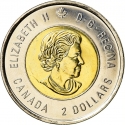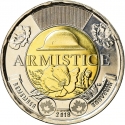You are about to finish your registration. Please check your mailbox (including spam folder). There should be a letter with a confirmation link. Check setting to make sure that your e-mail address is correct.
Send letter againDescription
With two minutes of silence each November 11, Canadians commemorate four years that changed the course of history. It is at the exact moment of Armistice, when the first modern war suddenly came to an end in 1918. In 2018 Royal Canadian Mint honoured the 100th Anniversary of the Armistice 1918 with this special $2 coin.
The Armistice of 11 November 1918 was the armistice that ended fighting on land, sea and air in World War I between the Allies and their last opponent, Germany. Previous armistices had eliminated Bulgaria, the Ottoman Empire and the Austro-Hungarian Empire. Also known as the Armistice of Compiègne from the place where it was signed, it came into force at 11 a.m. Paris time on 11 November 1918 ("the eleventh hour of the eleventh day of the eleventh month") and marked a victory for the Allies and a complete defeat for Germany, although not formally a surrender. Although the armistice ended the fighting, it needed to be prolonged three times until the Treaty of Versailles took effect on 10 January 1920.
Obverse

|
Fourth portrait of HM Queen Elizabeth II, when she was 77 years old, facing right and surrounded with the inscription. A maple leaf above, country name and denomination below. ELIZABETH II D·G· REGINA |
|---|---|
Reverse

|
Depicts a poignant pairing of two symbols of remembrance. ARMISTICE |
| Edge |
CANADA * 2 DOLLARS * |
2 Dollars
4th portrait
KM# 2580.2
Characteristics
| Type | Commemorative Issue (Circulating) |
| Material | Bi-Metallic |
| Ring | Nickel Plated Steel |
| Center | Brass Plated Aluminium Bronze |
| Weight | 6.99 g |
| Diameter | 28 mm |
| Thickness | 1.8 mm |
| Shape |
|
| Alignment | Medal |
| Mint |
Royal Canadian Mint (RCM)
|



